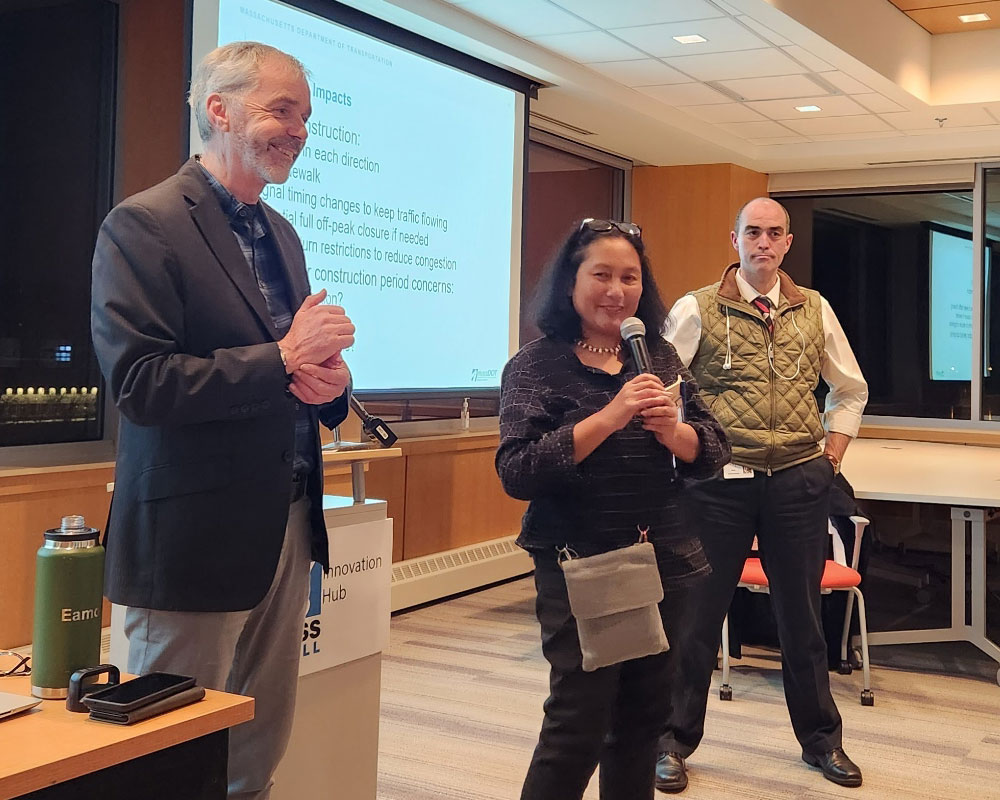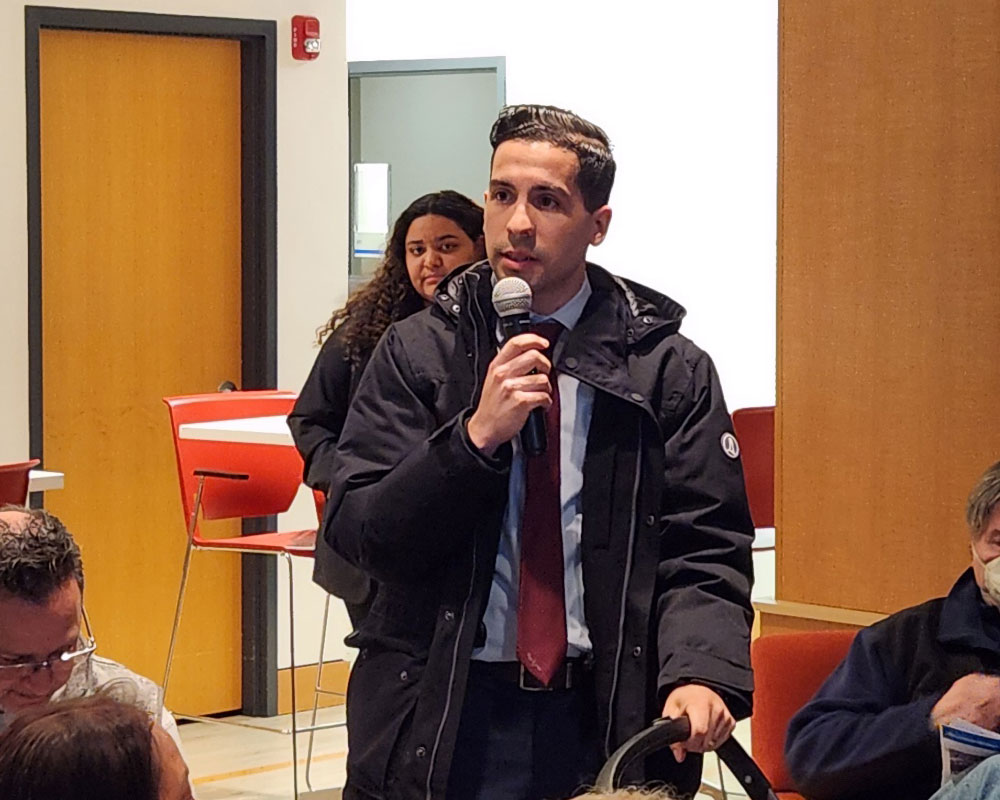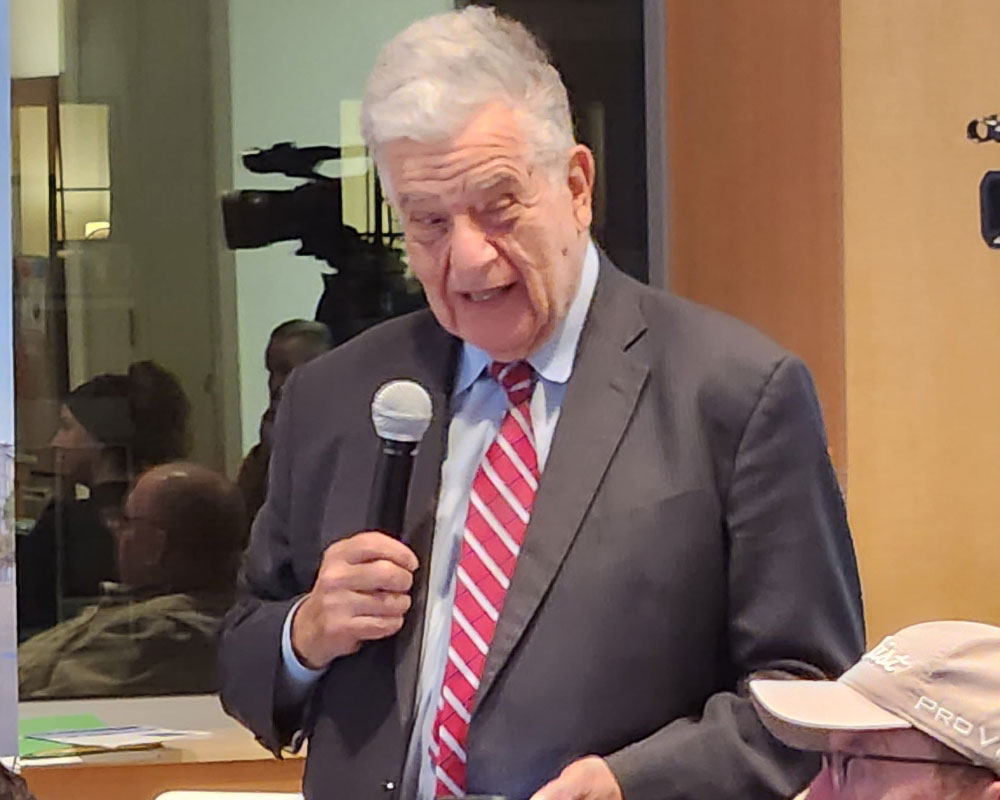(Additional photographs below.)
Keeping street and boat traffic moving, decorative lighting and possible salvage of one tower were among the key issues raised during a public hearing on plans to replace the Pfc. Ralph T. Basiliere Bridge.
A Massachusetts Department of Transportation meeting Thursday night was called to gather public feedback before designing of the estimated $150 million replacement bridge—between downtown Haverhill and Bradford—scheduled to be complete in 2027. Eamon Kernan, MassDOT project manager, addressed expectations.
“We’re hoping the new structure will be an homage to the existing structure. It is not going to match it. It is going to be a modern bridge. It is going to be a new bridge, but we don’t want to completely clean the slate and put in, basically, like a highway bridge, if you want to call it that,” he said.
Nathanial Cabral-Curtis, who is overseeing public involvement, said that while it was clear when studies began in 2018 the existing deck and arches could not be saved, there was at least hope the foundation could be reused to support new piers.
“We realized, no, we can’t save any part of it,” he said, explaining even the foundation of the 1925-era bridge is not capable of holding the new bridge.
Salvaging an existing tower for placement on the center of new bridge is also considered unlikely since there will be fewer piers to support symmetrical placement. Kernan said, however, it is possible one of the towers could be saved and placed near the rail trail.
“If we can take one of these towers off and move it, maybe over to the Bradford Rail Trail or somewhere else in the general area so that it is not lost completely and the history part of it is kept,” he explained.
There was consensus among those attending, including Haverhill Mayor James J. Fiorentini, that decorative lighting be placed above and possibly over the rail trail. Bridge architect Etty Padmodipoetro agreed, but with a reservation.
“We will be respecting the dark sky so we want to make sure it is well lit—it can enhance the bridge—but not becoming light pollution,” she explained.
Fiorentini said, “This is a beautiful bridge. We want it to remain beautiful. It would be even more beautiful if it were lit. We’re all sorry the towers can’t remain where they are.”
The bridge is currently 68 feet wide and engineers hope to complete a 75-foot-wide structure which would use a small amount of land on the Water Street side of the right-of-way. Preliminary concepts, which would show possible travel lanes, sidewalks and bicycle path, could be ready by the end of the month, but the direction of the final design isn’t expected until the middle of this summer.
During construction, officials said, one lane of traffic will be maintained in each direction for the 30,000 vehicles per day that use it. Traffic patterns north to Bailey and Ginty Boulevards and south to Middlesex Street will likely will be reconfigured. One sidewalk is also expected to remain available. Kernan did not sugarcoat the expected result.
“It is going to be a nightmare. It is going to be a nightmare for design, but ultimately be dedicated to come up with the best solution.”
Councilor Melinda E. Barrett called for the state to double the number of travel lanes during the three years of construction.
“I think it is important to maintain two lanes in both directions—north and south—because otherwise you’ll have gridlock all the way to Ward Hill,” she said.
Officials all but ruled out a temporary bridge, pushed by Haverhill City Councilor Joseph J. Bevilacqua, to mitigate traffic problems. Bevilacqua suggested, what he described as similar to bridges built by the military during World War II, a span between the former Friends Landing property on Water Street to a former lumberyard on the Bradford side of the Merrimack. Kernan said a temporary bridge would cost between $74 and $100 million with such additional expenses as relocating utilities twice.
Bevilacqua also suggested placing a covering over sidewalks not only to shelter pedestrians, but as a decorative element.
Crescent Yacht Club Commodore Rick LeBlanc not to forget about the safety of boaters. “The bridge as it is now is dangerous. I don’t know if there is any way there could be netting put under there or anything. If you’ve ever gone under that bridge on a boat, you see the chunks of cement fall down” he noted.
City Council President Timothy J. Jordan praised the plan for bicycle paths, while Council Vice President John A. Michitson nudged officials for the detailed timeline that was presented. In addition, resident Larry Olasky suggested the addition of rail trail lighting, while Community Development Director Andrew K. Herlihy asked for the addition of “scenic overlooks” for pedestrians to view the Merrimack River.



